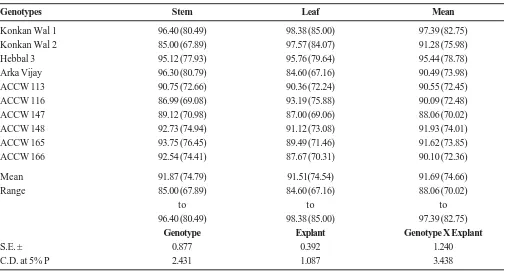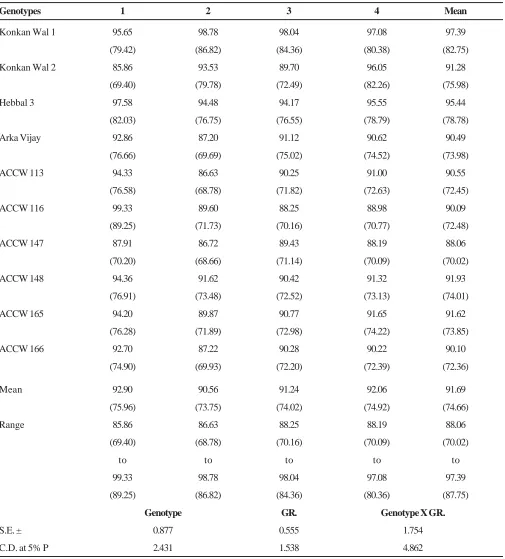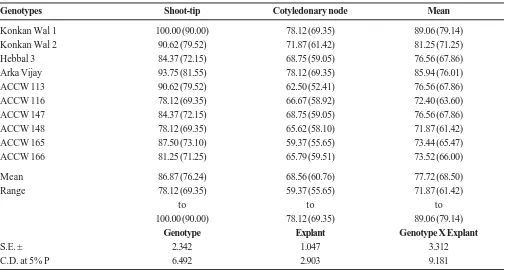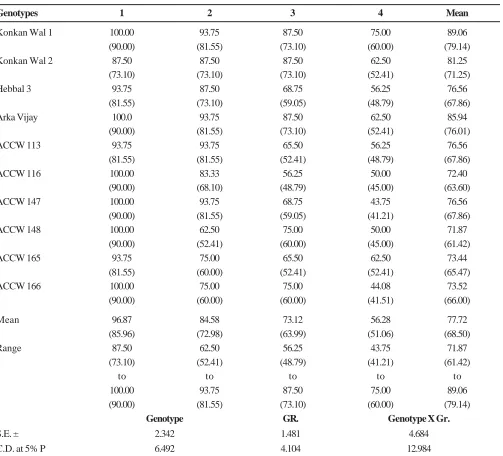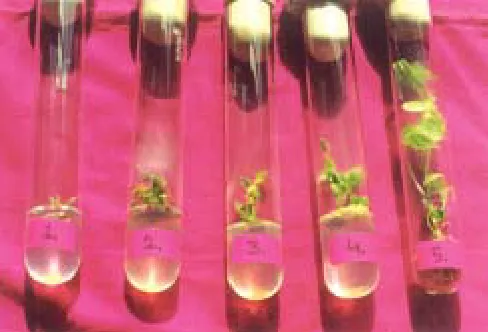* Present address: Bejo Sheetal Seeds Pvt. Ltd., Jalna-431203 (Maharashtra)
6 0
Indian J. Plant Physiol., Vol. 10, No. 1, (N.S.) pp. 60-65 (Jan.-Mar., 2005)
STUDIES ON CALLUS INITIATION AND PLANTLET REGENERATION IN FIELD
BEAN (LABLAB PURPUREUS (L.) SWEET)
V.P. KALE*
Plant Biotechnology Unit, Konkan.Krishi.Vidyapeeth., Dapoli-415712 Received on 25 Feb., 2004; Revised on 10 Dec., 2004
SUMMARY
The studies on callus initiation and plantlet regeneration in field bean were undertaken by using B5 medium, ten genotypes and different growth regulators. The stem and leaf explants were used for callus induction, while shoot-tip and cotyledonary node explants were used for plantlet regeneration. The response for per cent callus induction and plantlet regeneration varied with genotype, explants and growth regulators. It was observed that the genotype Konkan Wal 1, explant stem and growth regulator combination of 2.5 mg/l IAA + 5.0 mg/I BA recorded maximum callus induction. The genotype Konkan Wal 1, explant shoot-tip and growth regulator level of 0.1 mg/l BA recorded maximum plantlet regeneration.
Key words: Callus, field bean, growth regulator, regeneration
INTRODUCTION
The field bean [Lablab purpureus (L.) Sweet] is an important legume grown in India. Callus cultures are used for inducing genetic variability and recovery of variant plants. The plants regenerated from callus show considerable amount of variation known as somaclonal variation. These variations can be directly used in crop improvement [Karp 1995, Jain 2000]. In vitro culture of shoot-tip meristems has many applications in crop improvement programs. It can be used to obtain virus free material, clonal propagation and germplasm conservation [Kartha et al. 1981, Kale 2004]. Not much work has been carried out on in vitro culture of field bean. The present investigation was undertaken to study callus initiation and plantlet regeneration in field bean.
MATERIALS AND METHODS
The seeds of ten field bean genotypes, viz. Konkan Wal 1, Konkan Wal 2, Hebbal 3, Arka Vijay, ACCW
113, ACCW 116, ACCW 147, ACCW 148, ACCW 165 and ACCW 166 were first washed with teepol in running tap water for 10-15 minutes. The seeds were then rinsed in 70% ethanol for 2-3 minutes and washed 4-5 times with distilled water. The surface sterilization was done with 0.1% HgCl2 for 5 minutes. The seeds were finally washed thoroughly with distilled water for 4 to 5 times. The seeds were then inoculated on B5 medium without any growth regulators. The stem and leaf explants were taken for callus induction while shoot-tip and cotyledonary node for plantlet regeneration. The explants of about 0.5 cm long were excised from 7-day old seedlings and inoculated on B5 medium containing 3 per cent sucrose and 0.8 per cent agar supplemented with IAA and BA at various concentrations and combinations. The pH of the medium was adjusted to about 5.8 before autoclaving at 15 psi for 15 minutes. The cultures were kept in darkness for callus induction while they were maintained at 25 ± 2ºC in light (1600 lux from cool white fluorescent tubes) for plantlet regeneration. The data were recorded on per cent callus initiation and plantlet regeneration.
RESULTS AND DISCUSSION
Callus Induction
The genotype of the donor plant may be the most important factor in callus induction [Jain and Chopra 1988]. The data showing per cent response of different genotypes of field bean to callus induction using stem and leaf explants on B5 medium are presented in Table 1. It is observed that, the per cent response of genotypes ranged from 88.06 to 97.39. The maximum response (97.39%) was recorded by Konkan Wal-1, while minimum response (88.06%) was recorded by ACCW-147. The genotypes Konkan Wal-1 and Hebbal-3 were found to be statistically significant over all the remaining genotypes. The genotypes, Konkan Wal-2 and Arka Vijay were at par with each other, while Konkan Wal-2 was significantly superior to the remaining genotypes.
The maximum response (91.87%) for callus induction was recorded by stem explant, while minimum response (91.51%) was recorded by leaf explant. With the stem
explant, maximum response (96.40%) was recorded by Konkan Wal-1, while minimum (85.00%) was recorded by Konkan Wal-2. With the leaf explant, maximum response (98.38%) was also recorded by Konkan Wal-1, while minimum response (84.60%) was recorded by Arka Vijay.
The effect of growth regulator combinations on callus induction of field bean genotypes are presented in Table 2. It is evident that, growth regulator combinations created variable response for callus induction. The maximum response (92.90%) for callusing was recorded in growth regulator combination 2.5 mg/l IAA + 5 mg/l BA while, the minimum response (90.56%) was recorded by growth regulator combination 2.5 mg/l NAA + 5 mg/l BA. The percent callus induction ranged from 85.86 to 99.33, 86.63 to 98.78, 88.25 to 98.04 and 88.19 to 97.08 with growth regulator combinations of 2.5 mg/l IAA + 5 mg/l BA, 2.5 mg/l NAA + 5 mg/l BA, 1.0 mg/l IAA + 10 mg/ l BA and 1.0 mg/l NAA + 10 mg/l BA, respectively. The callus developed from stem expalnt on MS + 2.5 mg/l IAA + 5.0 mg/l BA is shown in fig. 1.
Table 1. Genotypic variability in relation to explants for per cent callus induction on B5 medium.
Genotypes Stem Leaf Mean
Konkan Wal 1 96.40 (80.49) 98.38 (85.00) 97.39 (82.75)
Konkan Wal 2 85.00 (67.89) 97.57 (84.07) 91.28 (75.98)
Hebbal 3 95.12 (77.93) 95.76 (79.64) 95.44 (78.78)
Arka Vijay 96.30 (80.79) 84.60 (67.16) 90.49 (73.98)
ACCW 113 90.75 (72.66) 90.36 (72.24) 90.55 (72.45)
ACCW 116 86.99 (69.08) 93.19 (75.88) 90.09 (72.48)
ACCW 147 89.12 (70.98) 87.00 (69.06) 88.06 (70.02)
ACCW 148 92.73 (74.94) 91.12 (73.08) 91.93 (74.01)
ACCW 165 93.75 (76.45) 89.49 (71.46) 91.62 (73.85)
ACCW 166 92.54 (74.41) 87.67 (70.31) 90.10 (72.36)
Mean 91.87 (74.79) 91.51(74.54) 91.69 (74.66)
Range 85.00 (67.89) 84.60 (67.16) 88.06 (70.02)
to to to
96.40 (80.49) 98.38 (85.00) 97.39 (82.75)
Genotype Explant Genotype X Explant
S.E. ± 0.877 0.392 1.240
C.D. at 5% P 2.431 1.087 3.438
Table 2. Genotypic variability in relation to growth regulator combination for callus induction on B5 medium.
Genotypes 1 2 3 4 Mean
Konkan Wal 1 95.65 98.78 98.04 97.08 97.39
(79.42) (86.82) (84.36) (80.38) (82.75)
Konkan Wal 2 85.86 93.53 89.70 96.05 91.28
(69.40) (79.78) (72.49) (82.26) (75.98)
Hebbal 3 97.58 94.48 94.17 95.55 95.44
(82.03) (76.75) (76.55) (78.79) (78.78)
Arka Vijay 92.86 87.20 91.12 90.62 90.49
(76.66) (69.69) (75.02) (74.52) (73.98)
ACCW 113 94.33 86.63 90.25 91.00 90.55
(76.58) (68.78) (71.82) (72.63) (72.45)
ACCW 116 99.33 89.60 88.25 88.98 90.09
(89.25) (71.73) (70.16) (70.77) (72.48)
ACCW 147 87.91 86.72 89.43 88.19 88.06
(70.20) (68.66) (71.14) (70.09) (70.02)
ACCW 148 94.36 91.62 90.42 91.32 91.93
(76.91) (73.48) (72.52) (73.13) (74.01)
ACCW 165 94.20 89.87 90.77 91.65 91.62
(76.28) (71.89) (72.98) (74.22) (73.85)
ACCW 166 92.70 87.22 90.28 90.22 90.10
(74.90) (69.93) (72.20) (72.39) (72.36)
Mean 92.90 90.56 91.24 92.06 91.69
(75.96) (73.75) (74.02) (74.92) (74.66)
Range 85.86 86.63 88.25 88.19 88.06
(69.40) (68.78) (70.16) (70.09) (70.02)
to to to to to
99.33 98.78 98.04 97.08 97.39
(89.25) (86.82) (84.36) (80.36) (87.75)
Genotype GR. Genotype X GR.
S.E. ± 0.877 0.555 1.754
C.D. at 5% P 2.431 1.538 4.862
Figures in parenthesis indicate arc-sin values
Fig. 1. Callus developed from stem explant on MS + 2.5 mg/l IAA + 5.0 mg/l BA
(71.87%) was recorded by ACCW-148. The mean response ranged from 71.87 to 89.06 percent. The genotypes Konkan Wal-1 and Arka Vijay were statistically at par with each other. The genotype Konkan Wal-1 is statistically significant over all the remaining genotypes.
The explants had highly significant effect on percent regeneration. The maximum regeneration (86.87%) was recorded by expalnt shoot-tip while minimum regeneration (68.56%) was recorded in cotyledonary node expalnt. The range of regeneration was from 78.12 to 100.00 percent and from 59.37 to 78.12 percent with shoot-tip and cotyledonary node explants, respectively. The shoot-tip expalnt was found better than cotyledonary node explant for plantlet regeneration (Kale 2004).
The relative ratio of auxin and cytokinin considerably influence the regeneration response (Sounder Raj et al.
1989). The morphogenic response of explants varies with combinations of growth regulators (Sounder Raj et al.
1991). The data regarding percent response to plantlet
Table 3. Genotypic variability in relation to explants for per cent plantlet regeneration on B5 medium.
Genotypes Shoot-tip Cotyledonary node Mean
Konkan Wal 1 100.00 (90.00) 78.12 (69.35) 89.06 (79.14)
Konkan Wal 2 90.62 (79.52) 71.87 (61.42) 81.25 (71.25)
Hebbal 3 84.37 (72.15) 68.75 (59.05) 76.56 (67.86)
Arka Vijay 93.75 (81.55) 78.12 (69.35) 85.94 (76.01)
ACCW 113 90.62 (79.52) 62.50 (52.41) 76.56 (67.86)
ACCW 116 78.12 (69.35) 66.67 (58.92) 72.40 (63.60)
ACCW 147 84.37 (72.15) 68.75 (59.05) 76.56 (67.86)
ACCW 148 78.12 (69.35) 65.62 (58.10) 71.87 (61.42)
ACCW 165 87.50 (73.10) 59.37 (55.65) 73.44 (65.47)
ACCW 166 81.25 (71.25) 65.79 (59.51) 73.52 (66.00)
Mean 86.87 (76.24) 68.56 (60.76) 77.72 (68.50)
Range 78.12 (69.35) 59.37 (55.65) 71.87 (61.42)
to to to
100.00 (90.00) 78.12 (69.35) 89.06 (79.14)
Genotype Explant Genotype X Explant
S.E. ± 2.342 1.047 3.312
C.D. at 5% P 6.492 2.903 9.181
Figures in parenthesis indicate arc-sin values
Plantlet Regeneration
The data on percent response to regeneration in different genotypes using different explants are presented in Table 3. The maximum regeneration (89.06%) was recorded by Konkan Wal-1, while minimum regeneration
CALLUS INITIATION AND PLANTLET REGENERATION IN FIELD BEAN
Table 4. Genotypic variability in relation to growth regulator combinations for per cent pantlet regeneration on B5 medium.
Genotypes 1 2 3 4 Mean
Konkan Wal 1 100.00 93.75 87.50 75.00 89.06
(90.00) (81.55) (73.10) (60.00) (79.14)
Konkan Wal 2 87.50 87.50 87.50 62.50 81.25
(73.10) (73.10) (73.10) (52.41) (71.25)
Hebbal 3 93.75 87.50 68.75 56.25 76.56
(81.55) (73.10) (59.05) (48.79) (67.86)
Arka Vijay 100.0 93.75 87.50 62.50 85.94
(90.00) (81.55) (73.10) (52.41) (76.01)
ACCW 113 93.75 93.75 65.50 56.25 76.56
(81.55) (81.55) (52.41) (48.79) (67.86)
ACCW 116 100.00 83.33 56.25 50.00 72.40
(90.00) (68.10) (48.79) (45.00) (63.60)
ACCW 147 100.00 93.75 68.75 43.75 76.56
(90.00) (81.55) (59.05) (41.21) (67.86)
ACCW 148 100.00 62.50 75.00 50.00 71.87
(90.00) (52.41) (60.00) (45.00) (61.42)
ACCW 165 93.75 75.00 65.50 62.50 73.44
(81.55) (60.00) (52.41) (52.41) (65.47)
ACCW 166 100.00 75.00 75.00 44.08 73.52
(90.00) (60.00) (60.00) (41.51) (66.00)
Mean 96.87 84.58 73.12 56.28 77.72
(85.96) (72.98) (63.99) (51.06) (68.50)
Range 87.50 62.50 56.25 43.75 71.87
(73.10) (52.41) (48.79) (41.21) (61.42)
to to to to to
100.00 93.75 87.50 75.00 89.06
(90.00) (81.55) (73.10) (60.00) (79.14)
Genotype GR. Genotype X Gr.
S.E. ± 2.342 1.481 4.684
C.D. at 5% P 6.492 4.104 12.984
Figures in parenthesis indicate arc-sin values
(1). 0.1 mg/l BA, (2). 0.2 mg/l BA, (3). 0.1 mg/l IAA + 0.1 mg/l BA, (4). 0.5 mg/l IAA + 0.5 mg/l BA
regeneration in different genotypes using different growth regulator combinations are presented in Table 4. The growth regulator combinations created variable response for per cent regeneration. The mean response ranged
from 56.28 to 96.87 percent. The maximum (96.87%) and minimum (56.28%) regeneration was observed with 0.1 mg/l BA and 0.5 mg/l IAA + 0.5 mg/l BA, respectively. The plantlet regeneration from shoot-tip explant on MS + 0.1 mg/l BA is shown in fig.2.
V.P. KALE
REFERENCES
Jain, J., and Chopra, V.L. (1988). Genotypic differences in response to regeneration of in-vitro cultures of moth bean, (Vigna aconitifolia). Indian J. Exp. Biol. 26: 654-656.
Jain, S.M. (2000). Tissue culture induced variation in crop improvement. Euphytica 118: 153-166.
Fig. 2. Plantlet regeneration from shoot tip explant on MS + 0.1 mg/l BA (stages of plantlet regeneration)
Kale, V.P. (2004). In-vitro conservation of shoot-tips in field bean
(Lablab purpureus L. Sweet). In: Proc. UGC sponsored National Conference on Biotechnological Approaches in Conservation, Utilization and Improvement of Plant Wealth, 14-15 Feb., 2003, Abstract No. 11. Nanded, India.
Kale, V.P. (2004). Standardization of protocol for callus initiation and plantlet regeneration in field bean (Lablab purpurreus
L. Sweet). In: Proc. UGC sponsored National Conference on Biotechnological Approaches in Conservation, Utilization and Improvement of Plant Wealth, 14-15 Feb., 2003, Abstract No. 10. Nanded, India.
Karp, A. (1995). Somaclonal variation as a tool for crop improvement. Euphytica. 85: 295-302.
Kartha, K.K., Pahl, K., Leugn, N.L. and Mroginski, L.A. (1981). Plant regeneration from meristems of grain legumes. Can. J. Bot. 59: 1671-1679.
Sounder Raj, V., Tejavathi, D.H. and Nijalingappa, B.H.M. (1989). Shoot-tip culture in Dolichus biflorus L. Curr. Sci. 58:
1385-1388.
Sounder Raj, V., Nijalingappa, B.H.M. and Tejavathi, D.H. (1991).
In-vitro studies in Dolichos lablab var. lignosus Indian J. Exp. Biol. 29: 221-225.
CALLUS INITIATION AND PLANTLET REGENERATION IN FIELD BEAN
